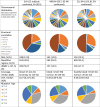High degree of polyclonality hinders somatic mutation calling in lung brush samples of COPD cases and controls
- PMID: 31882973
- PMCID: PMC6934450
- DOI: 10.1038/s41598-019-56618-1
High degree of polyclonality hinders somatic mutation calling in lung brush samples of COPD cases and controls
Abstract
Chronic obstructive pulmonary disease (COPD) is induced by cigarette smoking and characterized by inflammation of airway tissue. Since smokers with COPD have a higher risk of developing lung cancer than those without, we hypothesized that they carry more mutations in affected tissue. We called somatic mutations in airway brush samples from medium-coverage whole genome sequencing data from healthy never and ex-smokers (n = 8), as well as from ex-smokers with variable degrees of COPD (n = 4). Owing to the limited concordance of resulting calls between the applied tools we built a consensus, a strategy that was validated with high accuracy for cancer data. However, consensus calls showed little promise of representing true positives due to low mappability of corresponding sequence reads and high overlap with positions harbouring known genetic polymorphisms. A targeted re-sequencing approach suggested that only few mutations would survive stringent verification testing and that our data did not allow the inference of any difference in the mutational load of bronchial brush samples between former smoking COPD cases and controls. High polyclonality in airway brush samples renders medium-depth sequencing insufficient to provide the resolution to detect somatic mutations. Deep sequencing data of airway biopsies are needed to tackle the question.
Conflict of interest statement
T.G. reports personal fees from Astra Zeneca, Berlin-Chemie, Boehringer-Ingelheim, Chiesi, CSL-Behring, GSK, Novartis, and grants and personal fees from Grifols, outside the submitted work; and reports grants from the European Union during the conduct of the study. The other authors declare no competing financial and/or non-financial interests.
Figures



Similar articles
-
PIK3CA mutation as a distinctive genetic feature of non-small cell lung cancer with chronic obstructive pulmonary disease: A comprehensive mutational analysis from a multi-institutional cohort.Lung Cancer. 2017 Oct;112:96-101. doi: 10.1016/j.lungcan.2017.07.039. Epub 2017 Aug 7. Lung Cancer. 2017. PMID: 29191607
-
Novel biomarker genes which distinguish between smokers and chronic obstructive pulmonary disease patients with machine learning approach.BMC Pulm Med. 2020 Feb 3;20(1):29. doi: 10.1186/s12890-020-1062-9. BMC Pulm Med. 2020. PMID: 32013930 Free PMC article.
-
Dynamics of exhaled breath temperature after smoking a cigarette and its association with lung function changes predictive of COPD risk in smokers: a cross-sectional study.Arh Hig Rada Toksikol. 2019 Jun 1;70(2):123-129. doi: 10.2478/aiht-2019-70-3211. Arh Hig Rada Toksikol. 2019. PMID: 31246566
-
Asthma and smoking-induced airway disease without spirometric COPD.Eur Respir J. 2017 May 1;49(5):1602061. doi: 10.1183/13993003.02061-2016. Print 2017 May. Eur Respir J. 2017. PMID: 28461294 Review.
-
The relationship of cigarette smoking in Japan to lung cancer, COPD, ischemic heart disease and stroke: A systematic review.F1000Res. 2018 Feb 19;7:204. doi: 10.12688/f1000research.14002.1. eCollection 2018. F1000Res. 2018. PMID: 30800285 Free PMC article.
References
Publication types
MeSH terms
Substances
LinkOut - more resources
Full Text Sources
Medical

